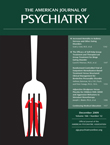Vocal Cord Dysfunction Arising From Vagal Nerve Stimulator Removal
To The Editor: In 2005, vagal nerve stimulation received approval for treatment of adult patients with refractory major depressive disorder. Adverse effects associated with vagal nerve stimulation implantation are cough, hoarseness, and dysesthesias of the throat related to electrical stimulation, along with rare cases of localized deep-tissue infection (1 – 3) . Seldom is removal of the device required, although it is recommended in cases of infection refractory to treatment (such as aspiration and antibiotics) or potential systemic infection (4) . We report the unique case of a patient requiring vagal nerve stimulator removal, which resulted in vocal cord hoarseness.
“Mr. B” was a 54-year-old man with a history of hypertriglyceridemia as well as depression refractory to treatment in multiple antidepressant trials. He had undergone vagal nerve stimulator implantation in November 2006. The procedure was well tolerated, and no adverse effects were reported. He seemingly appreciated an improvement in mood.
The patient first came to our unit when his clinical course was complicated by meningitis. Culture from CSF revealed pan-sensitive Staphylococcus aureus . An infectious diseases consult raised the concern that vagal nerve stimulator presented an infection source, which prompted explantation of the device (including the generator, leads, and wire coil) in March 2008. Subsequently, the patient developed hoarseness and left vocal cord paralysis.
Electromyographic investigation revealed abnormalities limited to the left thyroarytenoid muscle, suggestive of an incomplete left recurrent laryngeal nerve lesion. Review of Mr. B’s operative report was noteworthy for the observation that the vagus nerve was invested with scar tissue requiring “meticulous and tedious” excision. The etiology of the patient’s vocal cord paralysis was presumed to be the result of direct trauma related to scar tissue and wire-coil removal impinging upon the recurrent laryngeal nerve.
After 5 months of intensive speech therapy, the patient manifested nearly complete functional recovery, with marked improvement in vocal fatigue. However, stroboscopic-video vocal cord examination and follow-up electrodiagnostic investigations revealed a residual and permanent neurologic injury, even at 9 months postinjury. The patient elected not to have another vagal nerve stimulation implant and instead pursued antidepressant pharmacotherapy, with adequate response.
Although deep-tissue infection arising after vagal nerve stimulator implantation is uncommon, there can be considerable morbidity in instances in which infection occurs (1 , 4) . The literature to date suggests that these problems are generally encountered within 1 month postimplantation (4) .
The present case is the first, to our knowledge, in which meningitis in an adult patient prompted vagal nerve stimulation hardware removal and, most notably, scar tissue excision and hardware removal precipitated a permanent left recurrent laryngeal nerve injury. The most appropriate and efficacious approaches to treating deep-tissue infection and meningitis arising after implantation is limited in the available literature. Because of hazards encountered in the excision of scar tissue associated with explantation, treatment with intravenous antibiotics while retaining the wire coil in situ may be the most prudent first-line approach to the management of complications (1) . Refractory, persistent infection, despite conservative treatment, might necessitate eventual device removal. Patients considering vagal nerve stimulation treatment will need to be made aware of the risks of infection and potential complications if explantation is ever required.
1. Air EL, Ghomri YM, Tyagi R, Grande AW, Crone K, Mangano FT: Management of vagal nerve stimulator infections: Do they need to be removed? J Neurosurg Pediatr 2009; 3:73–78Google Scholar
2. Daban C, Martinez-Aran A, Cruz N, Vieta E: Safety and efficacy of vagus nerve stimulation in treatment-resistant depression: a systematic review. J Affect Disord 2008; 110:1–15Google Scholar
3. Rush AJ, Marangell LB, Sackeim HA, George MS, Brannan SK, Davis SM, Howland R, Kling MA, Rittberg BR, Burke WJ, Rapaport MH, Zajecka J, Nierenberg AA, Husain MM, Ginsberg D, Cooke RG: Vagus nerve stimulation for treatment-resistant depression: a randomized, controlled acute phase trial. Biol Psychiatry 2005; 58:347–354Google Scholar
4. Patel NC, Edwards MS: Vagal nerve stimulator pocket infections. Pediatr Infect Dis J 2004; 23:681–683Google Scholar



